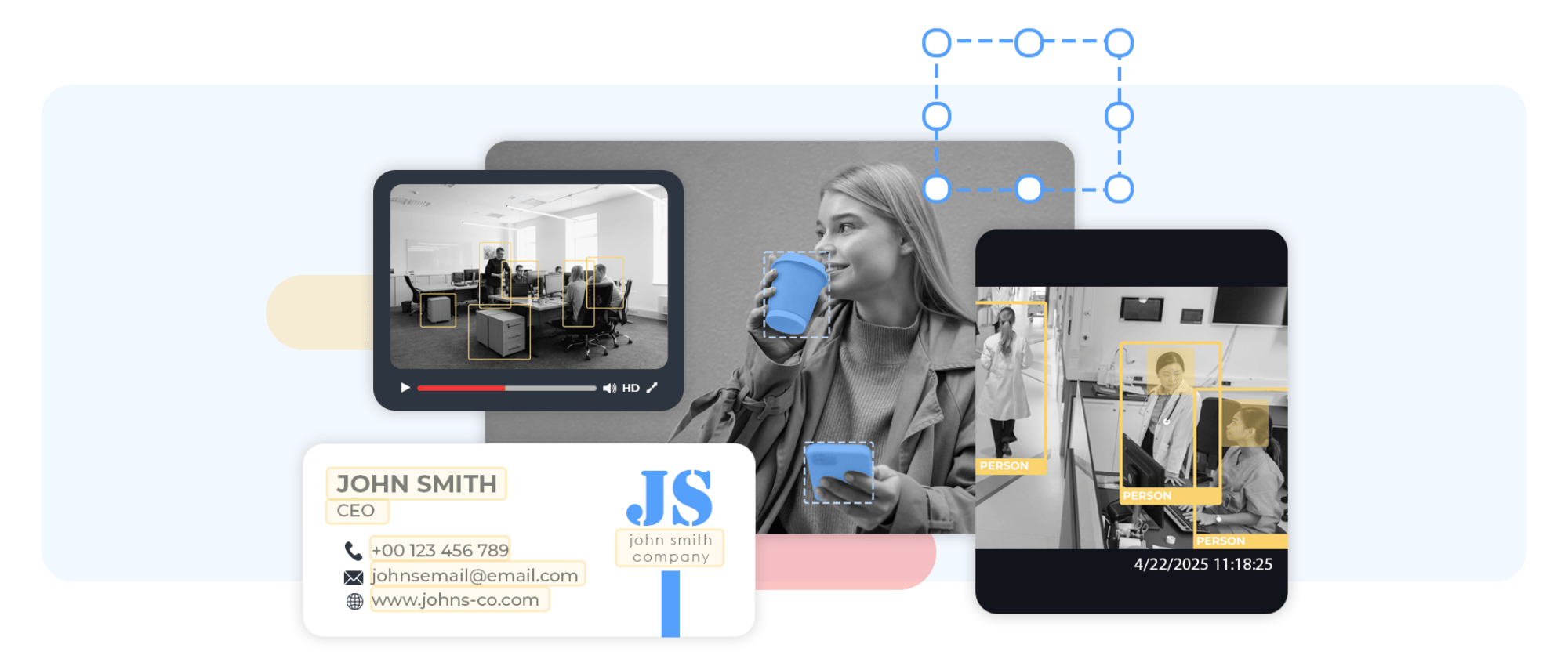Introduction
What is data annotation? It is the backbone of effective, unbiased, and fair AI, powering every intelligent solution with context-aware decision-making. In practice, it is a precise, human-led work that enriches each data point with details, teaching algorithms what something is and its unique traits. Consequently, annotation enables AI to grasp subtle nuances and interact with the world like a human through careful marking, describing, and highlighting key features. Whether a chatbot delivers the right answer or harmful content is flagged before it spreads, data annotation makes it possible.
Data Annotation: The Precision Behind AI’s Sharpest Decisions
How urgent is a customer inquiry? Where exactly is the pedestrian? Which part of an X-ray reveals an anomaly? Algorithms depend on precise, detailed clues, and data annotation delivers them all.
Simply put, it is about adding meaning to data so AI can identify objects, understand their relationship to the environment, and grasp their significance in each situation. The outcomes are insights that drive smarter decisions, faster responses, and more accurate actions.
Ultimately, data annotation is a complex and exacting process crucial for advanced AI applications. This is especially true in customer support, content moderation, medical imaging, autonomous driving, legal analysis, and beyond.
Accuracy is crucial in these fields because even minor errors can lead AI systems to misinterpret data, resulting in serious consequences. This affects both consumers and brands, particularly in critical areas such as safety, privacy, and health, among others.
Nevertheless, data annotation is a precise, time-intensive craft. It demands experts with deep domain knowledge and cutting-edge tools to get it right. But when done properly, that investment delivers powerful, game-changing results.
Types of Data Annotation
At the heart of every high-performing AI system lies expertly annotated data. Its type depends on the data and the specific needs of the intelligent application. Whether it is labelling images, tagging text, or mapping 3D environments, each task calls for specialised methods. Every category demands precise knowledge and dedicated skills to ensure accuracy and relevance. Below, we explore various annotation types, highlighting their diversity and potential. While these are common examples, the scope of annotation extends far beyond.
1. Image Annotation
Image annotation involves identifying and labelling visual elements so AI can interpret objects, people, and scenes precisely. This includes drawing bounding boxes around products, outlining irregular shapes using polygons, tagging facial features or body joints with key points, and assigning pixel-level classifications through semantic segmentation. For advanced applications, instance segmentation distinguishes between similar objects, while 3D cuboids and superannotation add depth, context, and even emotion. These methods are vital for industries such as autonomous driving, retail analytics, and healthcare diagnostics.
2. Text Annotation
Text annotation transforms unstructured language into structured, machine-readable insight. AI can understand language contextually by tagging named entities, such as people, locations, and organisations, and identifying sentiment, intent, and parts of speech. Techniques such as text classification and entity linking organise and connect information, while phrase chunking and content moderation tags help flag risks and support real-time decision-making. This is especially relevant in customer service, compliance monitoring, and digital content management.
3. Audio Annotation
Audio annotation enables AI systems to interpret spoken language and environmental sounds. It includes transcribing speech into text, distinguishing between speakers using diarisation, and tagging emotions or tones in voice recordings. Sound event detection identifies non-verbal cues, such as alarms, music, or background noise, while timestamping enables systems to track when specific words or actions occur. These capabilities are essential for training voice assistants, improving contact centre analytics, and supporting accessibility innovations.
4. Video Annotation
Video annotation brings context to moving images by labelling objects, actions, and interactions across sequences of frames. AI learns to follow people or vehicles throughout a video by tracking them frame by frame. It can also recognise gestures, detect incidents, and divide footage into meaningful scenes through action recognition and segmentation. Behaviour analysis further enables AI to interpret group dynamics and nuanced activities. This is crucial in security surveillance, entertainment, and sports performance analytics.
5. LiDAR and 3D Point Cloud Annotation
LiDAR and 3D point cloud annotation are also critical for applications that require spatial awareness, such as autonomous driving and robotics. Here, annotators label every point in a 3D environment to help AI identify surfaces, objects, and distances. When combined with sensor fusion, which synchronises data from cameras, LiDAR, radar, and GPS, AI systems gain a much deeper and more comprehensive understanding of complex real-world environments.
6. Sensor Data Annotation
Sensor data annotation supports IoT ecosystems and industrial automation by labelling time-series data from devices measuring temperature, movement, sound, and more. Each data point is analysed for patterns, anomalies, or event triggers. This process enables smarter computerisation, more accurate predictive maintenance, and optimised machine performance across various industries.
7. Code Annotation
Code annotation involves labelling software components, so AI systems can better understand and manipulate programming data. This includes tagging functions, syntax, variables, or code blocks with their purpose or output. This initiative helps train AI models to support intelligent coding assistants, debug software, and even generate new lines of code. It is increasingly relevant in software development and automated testing tools.
8. Medical and Legal Document Annotation
Medical and legal annotation plays a pivotal role in domains where accuracy is non-negotiable. In healthcare, specialists label anomalies in diagnostic scans such as X-rays, MRIs, or CT images, enabling AI to support faster and more reliable diagnoses. In legal, annotators highlight contract clauses, named entities, and sensitive terms to train AI for document review, legal research, and compliance automation.
9. Multilingual Annotation
Multilingual annotation ensures that all the services, from text to image to video, can be delivered in dozens of languages. This includes linguistic, cultural, and regional nuance that allows AI to operate effectively across global markets. As a result, multilingual annotation enables brands to scale intelligent solutions worldwide while maintaining local relevance, fairness, and usability.
Why Data Annotation Is Critical for AI Models
Data annotation is a crucial step in the machine learning pipeline. It strengthens an AI model’s ability to train effectively, improve performance, and generate accurate insights from new, unseen data. Whether applied to image recognition, natural language processing, sentiment analysis, or other complex tasks, annotation remains pivotal in enhancing accuracy, adaptability, and overall effectiveness across industries.
AI Needs Annotated Examples, Not Intuition
AI does not learn in the same way humans do. While people rely on reasoning, experience, and social context to acquire knowledge, AI systems require explicit examples to make sense of the world.
Data annotation bridges this gap, offering carefully labelled samples that allow models to recognise patterns, interpret meaning, and perform specific tasks.
Without this guidance, AI lacks the intuitive understanding necessary to operate effectively or responsibly.
The Power of Supervision in AI Training
The supervised nature of data annotation plays an essential role in both machine learning and artificial intelligence.
It involves classifying and labelling data with contextual information, such as categories, types, or attributes, to build high-quality, structured training datasets.
These labelled examples act as reference points, helping AI systems learn, adapt, and perform reliably in real-world environments.
Balancing Benefits and Challenges in Data Annotation
Accurate data annotation offers powerful advantages from both technical and business standpoints. Yet, the path to these benefits is complex, with notable challenges that require careful navigation. Mastering this balance is essential for the success of AI initiatives and the value they deliver.
Unlocking Potential While Navigating Obstacles
High-quality data annotation ensures precise control over AI outputs, making insights more reliable and actionable. This boosts decision-making, operational efficiency, competitive advantage, and innovation potential.
However, achieving this requires overcoming key hurdles. To fuel the process, large volumes of relevant legal data must be strategically sourced from internal databases, public resources, or crowdsourcing.
Speed is critical, too, making automation tools vital for scaling annotation without sacrificing quality.
Maintaining consistency requires continuous monitoring of annotation methods while ensuring security is non-negotiable when handling sensitive information, which necessitates robust protocols and regular audits.
Finally, human bias in annotation can skew results, so regular training and oversight are essential to preserve fairness and accuracy.
Addressing these challenges head-on ensures data annotation delivers its full promise, empowering AI models to perform at their best.
Better data annotation trains AI to grasp intent, not just labels. Capturing tone, urgency, or sarcasm helps models understand human nuance and emotion. It is not just about accuracy, but also empathy, says Raghu Para of Ford Motor Company in an article published by Forbes.
According to McKinsey, proper data annotation can boost AI fairness and performance by up to 35%. This is more than a technical upgrade; it marks the difference between bias and balance. Building ethical AI requires precision, ongoing curation, and careful monitoring.
Data Annotation Services: In-House vs Outsourced
Choosing the right approach to data annotation is critical for any organisation striving to build reliable, high-performing AI systems. The key question for managers is whether to keep the process in-house or outsource it. This decision requires carefully analysing both options, including their costs, scalability, access to specialised talent, quality control, and long-term impact. While in-house teams may offer closer oversight and internal alignment, outsourcing can provide flexibility, multilingual expertise, and faster turnaround, especially for large-scale or complex projects. The right choice depends on your data volume, timeline, and the degree to which central annotation is integral to your core operations.
When Internal Teams Face the Scalability Wall
Managing processes in-house offers direct control and may suit companies with niche, highly specialised needs or smaller, single-market operations.
However, the reality is that internal annotation comes with significant challenges, including ongoing recruitment, upskilling, and retaining skilled annotators.
It also entails the need for continuous investment in tools and infrastructure, as well as the pressure to deliver at scale without compromising quality or speed.
As projects grow in complexity and volume, resource bottlenecks, missed deadlines, and inconsistent quality can quickly become roadblocks to innovation.
Operational Excellence Through Smart Outsourcing
This is where data annotation outsourcing becomes a strategic advantage. By partnering with specialised providers like Conectys, businesses gain instant access to a global pool of trained annotators, advanced tools, and robust quality control processes.
Outsourcing data annotation services allows them to scale rapidly, flexibly adjusting resources to meet changing project demands or sudden surges. It also brings cost efficiencies, eliminating the need for heavy upfront investment in infrastructure and ongoing operational overhead.
Most importantly, professional providers ensure data accuracy and consistency through proven workflows, which helps maintain the integrity of your AI models and reduces bias.
Nevertheless, choosing a data annotation partner that delivers is crucial, as this decision directly impacts the accuracy, reliability, and safety of your AI systems.
What are the best practices for data annotation?
Following best practices for data annotation is a chance to succeed in managing AI-driven projects. Below are a few suggestions and tips on how to build an efficient annotation best practice strategy.
Initiate precise data labelling for valuable yet broad coverage.
Develop comprehensive annotation guidelines for uniformity
Establish clear communication channels among annotators.
Implement a feedback loop for insights and challenges.
Maintain transparent documentation for audits.
Balance human annotators and software strengths.
Regularly assess and refine the annotation process
Anticipate scalability challenges and plan for expansion.
Explore cost-effective options for data quality.
Why Choose Conectys for Data Annotation & Trust and Safety?
As AI and machine learning continue to reshape industries, the quality and integrity of data have become mission-critical. From content moderation to model training, organisations need partners that understand complexity and deliver with precision, speed, and care. That is where Conectys comes in.
Data Annotation & Trust and Safety: Conectys’ Strategic Advantage
With over 20 years of experience, Conectys is proud to be among the trusted providers of secure, scalable outsourcing services.
Our global team combines human expertise with automation, supporting clients in over 100 languages with a nuanced understanding and contextual sensitivity.
Today, we manage annotations across all major data types, including text, audio, images, video, and more. Trust and Safety, especially content moderation, is where we shine.
Nevertheless, we continually expand, adapt, and refine, quietly powering smarter, safer AI-driven decisions that prioritise data privacy, accuracy, and fairness.
Conclusion
In summary, with all the benefits and challenges to overcome, data annotation is a powerful tool for enhancing the performance of machine learning models. It helps unlock the full potential of artificial intelligence, elevating analytical capabilities across diverse industries, including social media, gaming, travel and hospitality, e-commerce, finance and various autonomous systems. As the demand for data annotation increases due to its critical role in model training, the field is poised for further development, driven by technological advancements and collaborative efforts, making it a key player in the ongoing evolution of artificial intelligence.
Feeling inspired? Let’s talk!
Looking to outsource your annotation or labelling tasks? Our team of experts helps companies scale high-quality datasets for AI and machine learning. Learn more about our services.
























